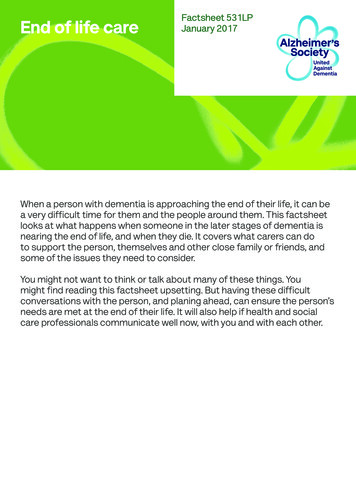
Transcription
End-of-Life Carefor Brain Tumor PatientsManual for Health Care ProvidersAUTHORS:Susan M. Chang, MDErin Dunbar, MDVirginia Dzul-Church, MDLaura Koehn, MDMargaretta S. Page, RN, MSNeuro-Oncology Gordon Murray Caregiver ProgramUNIVERSITY OF CALIFORNIA, SAN FRANCISCO
End-of-Life Care for Brain Tumor PatientsManual for Health Care ProvidersCONTENTS:INTRODUCTION . . . . . . . . . . . . . . . . . . . . . . . . . .1Neuroanatomy . . . . . . . . . . . . . . . . . . . . . . . . . . . . . .2THE USE OF STEROIDS . . . . . . . . . . . . . . . . . . . .3Role of Steroids . . . . . . . . . . . . . . . . . . . . . . . . . . . . .3Managing Steroids . . . . . . . . . . . . . . . . . . . . . . . . . . .4Side Effects . . . . . . . . . . . . . . . . . . . . . . . . . . . . . . . .4SYMPTOM MANAGEMENT . . . . . . . . . . . . . . . . . .7Drowsiness . . . . . . . . . . . . . . . . . . . . . . . . . . . . . . . . .8Headaches . . . . . . . . . . . . . . . . . . . . . . . . . . . . . . . . . 10Focal Neurological Symptoms . . . . . . . . . . . . . . . . . . 11Cognitive, Behavioral, and Emotional Changes . . . . 13Seizures . . . . . . . . . . . . . . . . . . . . . . . . . . . . . . . . . . . 16Delirium . . . . . . . . . . . . . . . . . . . . . . . . . . . . . . . . . . . . 22Dysphagia . . . . . . . . . . . . . . . . . . . . . . . . . . . . . . . . . . 25SOCIAL ISSUES . . . . . . . . . . . . . . . . . . . . . . . . . . . 27Children in the Home . . . . . . . . . . . . . . . . . . . . . . . . . 28Caregiver Concerns . . . . . . . . . . . . . . . . . . . . . . . . . . 29CONCLUSION . . . . . . . . . . . . . . . . . . . . . . . . . . . . 31
IntroductionThe goal of this manual is to provide an overview ofwhat health professionals may expect, as well as offerguidance, in caring for someone with a progressive,life-threatening brain tumor, with a particular focus on endof-life issues.Although some of the problems brain tumor patientsexperience at the end of life are common with many otherforms of cancer, there is a subset of challenging problemsunique to patients with brain tumors. In fact, the end-of-lifephase for brain tumor patients tends to have a different coursethan general cancer patients.The intent of this manual is to suggest recommendationsregarding disease-specific symptoms. Over time,recommendations will likely change as new supportivetreatments are incorporated into clinical care. We understandthat each patient’s situation is unique and that the end of life isdifferent for each patient. Some of these recommendationsmay not be pertinent to a particular situation.We hope that you will use this asa guide to supplement your knowledgeof end-of-life care.End-of-Life Care for Brain Tumor Patients / Manual for Health Care ProvidersPAGE 1
NeuroanatomyBrain tumors represent a wide variety of tumor types that either originate in the brain or havemetastasized from somewhere else. Because the symptoms commonly seen in the end-of-life phaseof brain tumor patients are a consequence of tumor location, it may be helpful to have a generalsense of the anatomy of the brain. Knowing where the tumor is located will help you anticipate whattype(s) of symptoms you may encounter. Below is a diagram of the brain outlining the major areas anda summary of the major functions.FRONTAL LOBE: Movement, intelligence,reasoning, behavior, memory, personality,planning, decision-making, judgment,initiative, inhibition, and moodPARIETAL LOBE: Intelligence, reasoning,knowing right from left, language,sensation, reading, and understandingwhere the body is in spaceOCCIPITALLOBE: Visionand perceptionTEMPORAL LOBE: Speech,behavior, memory, hearing,vision, and emotionsBRAINSTEM: Heart rate, blood pressure, cranialnerve connections (smell, taste, eye movements),and all connections from brain to spinal cordcarrying motor and sensory informationCEREBELLUM:Balance, coordination,and muscle toneEnd-of-Life Care for Brain Tumor Patients / Manual for Health Care ProvidersPAGE 2
The Use of SteroidsVIGNETTE:A 42-year-old woman with glioblastoma multiforme hasbeen noted to have worsening dull headache, which is worstin the morning, with associated nausea and vomiting.She has taken multiple pain medications includingacetaminophen, ibuprofen, and oxycodone without relief.She has also taken ondasetron and prochlorperazinewith moderate relief of her nausea. What else should youconsider to help with her symptoms?Role of SteroidsWhat is the role of steroids in treating patients withprimary brain tumors? What are indications for use?A steroid such as dexamethasone is the most commonmedication prescribed to brain tumor patients to controlcerebral edema and in turn manage symptoms. That said,there are many side effects and complications related totaking the drug that are particularly important to be aware ofin end-of-life care.Corticosteroids are hormonal molecules that can crossthe blood–brain barrier and act as analgesic agents by(1) decreasing inflammation by inhibiting the synthesis ofprostaglandin and (2) reducing tissue edema by decreasingvascular permeability. Due to these mechanisms, corticosteroids are the mainstay of treatment for relief of symptomsof increased intracranial pressure resulting from a brain tumor.These symptoms include nausea, vomiting, and headache,as well as focal neurological deficits such as weakness andlanguage dysfunction.End-of-Life Care for Brain Tumor Patients / Manual for Health Care ProvidersPAGE 3
Managing SteriodsHow do you manage steroids? What is thesteroid of choice?Corticosteroids, including hydrocortisone,dexamethasone, prednisone, prednisolone, andmethylprednisolone, are the mainstay of treatment of increased brain pressure. Steroid dosesshould be adjusted to maximize pain relief andminimize side effects.Dexamethasone (Decadron) is the corticosteroid best supported by clinical experience,evidence, and guidelines issued by expert panel.It causes less fluid retention because of its lessermineralocorticoid effect, has a longer half-lifeand thus can be taken once daily, and offers ahigher potency.What is a good trial and how do I titratethe dose?Each patient warrants a brief trial of corticosteroids for symptom control of headache,nausea, and vomiting. Administration of corticosteroids should preferably not take place laterthan 2 PM in order to minimize the undesirableeffects of insomnia and restlessness as wellas to maximize the desirable effects, such asanalgesia, support of daytime alertness, and toimprove appetite. Common regimens include:4-6 mg oral daily for mild symptoms; 8 mg oraldaily with breakfast for moderate symptoms;and 8 mg orally at breakfast and 8 mg at lunchfor severe symptoms. Three days may bean adequate trial for many situations (e.g.,headache), with tapering soon after initiationto a minimum effective dose with the leastside effects. The corticosteroid should bediscontinued if not found to benefit the individualwithin a week. If effective, the corticosteroidshould be maintained at the minimum dose thatprovides sufficient symptom control with theleast side effects. In general, patients should bemaintained on the corticosteroid for less than3 weeks, but the decision of when and whetherto discontinue the corticosteroid should hinge onpatient-specific factors (i.e., prognosis, likelihoodof side effects from withdrawal, potential toexacerbate other symptoms being maskedby the drug).How and when do I taper steroids?Because most corticosteroid side effectsmanifest over the long-term, general consensusholds that these drugs are best used for a limitedtime, at the lowest effective dose, and withfrequent monitoring. Corticosteroids are advisedfor short-term courses of therapy, from 1 to3 weeks. Corticosteroids are used for longerthan 3 weeks for patients who have a short- tomedium-term prognosis (i.e., 3 months lifeexpectancy) and in whom side effects are unlikelyto develop in the time remaining. In most casessteroid doses are maintained through the end-oflife period, until the patient stops taking oralmedications. If it was decided to stop the steroid,it must be tapered slowly over a 2-week timeperiod or longer in symptomatic patients.Dexamethasone has a long half-life, therefore itis recommended to decrease the dose by 50%every 4 days. If the patient has been on steroidsfor an extended period of time, a slower tapermay be needed. A common regimen would bedecreasing by 2 mg every 2 weeks. For patientswith a short- to medium-term prognosis, taperingthe medication to the lowest effective dose, butnot completely off the medication, provides thebest symptom support.Side EffectsWhat are the side effects of steroids?Since side effects of steroids can overlap withside effects of other medicines or symptoms fromthe brain tumor itself, being aware of commonsteroid side effects is very important. Someside effects of steroids include blurred vision,headache, mood and personality changes,psychosis, swelling of fingers, hands, feet andEnd-of-Life Care for Brain Tumor Patients / Manual for Health Care ProvidersPAGE 4
TABLE 1: MAJOR SIDE EFFECTS ASSOCIATED WITH CORTICOSTEROID THERAPYNEURO-PSYCHIATRICIn general, taper steroid to lowest effective dose. InsomniaSchedule last steroid dose before 2 PM.Sleeping aids: Melatonin: 1-5 mg at bedtime Nortryptiline: 25 mg at bedtime (max 100 mg) Mirtazapine: 7.5-15 mg at bedtime Lorazepam: 1 mg at bedtime Clonazepam: 0.5-2.0 mg at bedtime Mania/Psychosis/AgitationSupport for low-dose antipsychotics, if unable totaper steroid: Haloperidol (Haldol): 2-5 mg daily (or 1-2 mg q6H) Olanzapine: 2.5 mg daily, can titrate up to5-20 mg daily Quetiapine (Seroquel): 25-400 mg daily (dividedbid or tid). This is the most sedating of the drugs. Risperidone (Risperdal): 1-6 mg at bedtime Dysphoria/DepressionSSRI/SNRI if prognosis 6 months life expectancy: Escitalopram: 5-10 mg daily Citalopram: 10-20 mg daily (max 40 mg) Sertraline: 25-50 mg daily (max 100 mg) Venlafaxine: 37.5 mg daily (max 225 mg) Nortryptiline: 25 mg at bedtime (max 100 mg) Mirtazapine: 7.5-15 mg at bedtimePsychostimulant if prognosis 6 months lifeexpectancy: Methylphenidate: 2.5-30 mg daily in divided doses(last dose not after 4 PM) Ketamine: (oral solution) 0.5 mg/kg in divided dosesMUSCULOSKELETAL Myopathy; proximal muscle weakness;difficulty standing; falls Taper steroid to lowest effective dose. Aerobic exercise, resistance training, and physicaland occupational therapy may help prevent severity,enhance independence, and reduce falls.ENDOCRINE HyperglycemiaTreat similarly to diabetes mellitus, usually insulinbased. In hospice patients, there may be a higherthreshold to treat (i.e., only if blood sugar persistently 350s). AdrenalInsufficiencyMust taper slowly to prevent crisis and withdrawal(see Steroid Withdrawal Syndrome, page 6).GASTROINTESTINAL Gastritis Peptic Ulcer Disease Visceral PerforationContinue proton pump inhibitor (PPI) if previouslyindicated. Can consider starting prophylactic PPI if thepatient is receiving very high doses of glucocorticoidsor if he/she is at high risk for developing pepticulceration (e.g., previous peptic ulcer disease,concurrent anticoagulation, NSAID therapy).INFECTIOUS DISEASE Increased risk of typical and opportunisticinfection (fungal, zoster)Consider PCP prophylaxis in patients who arereceiving prolonged (more than 6 weeks) coursesof glucocorticoids. May not be indicated inhospice patients.Consider oral or topical anti-fungals for prophylaxisor at the development of symptoms.CARDIOVASCULAR Hypertension Arrythmia Lipid abnormalitiesRecommend not to check or treat in hospice patientsunless they are symptomatic.SKIN Thinning and purpura Acne, hirsutism Be aware of increased skin fragility, higher risk ofskin complications, and need for good skin care.Note: For all adverse effects: 1) Use the lowest dose of corticosteroid for the shortest period of time needed toachieve the treatment goals. 2) Treatment is needed of those pre-existing co-morbid conditions (e.g., diabetes mellitus,hypertension, arrhythmia, congestive heart failure, brewing infection) that may increase risk when corticosteroidsare required.This table includes commonly used medications to treat side effects of steroids. This list is not meant to be comprehensive. Many of these may or may not be on the hospice formulary and adjustments may be required. Providers areencouraged to be aware of non-tablet routes of administration for common brain tumor treatments, i.e., sub-lingual,transmucosal, subcutaneous, intradermal, rectal, and liquid suspension. Using non-tablet routes of administration oftenresults in improved symptom control especially near the end of life. Furthermore, it improves the ability of the family toparticipate in symptom management and increases the likelihood that the patient can remain at home.End-of-Life Care for Brain Tumor Patients / Manual for Health Care ProvidersPAGE 5
lower legs, weight gain, proximal muscleweakness (difficulty getting from sitting tostanding position, increased risk of falls), troublesleeping, high blood sugar, increased chance ofinfection, and gastrointestinal distress (ulcers).SUMMARY RECOMMENDATIONS For a patient experiencing pain that isinsufficiently relieved by NSAIDs or an opioid,conduct a short (i.e., 3-7 days) one-time trial ofthe corticosteroid in conjunction with theopioid, monitoring results against specificgoals in a defined time frame. If the patient tolerates the corticosteroidwell and reports pain relief, continue therapyat a dose of up to 16 mg orally, daily individed doses, e.g., breakfast and lunch.Dexamethasone is the current drug of choice. Discontinue the corticosteroid if it does notachieve the desired pain relief within apredefined time frame (typically 1 week). Maintain the patient on the minimum possiblecorticosteroid dose to achieve the desiredeffect, for up to 3 weeks. If prognosis is longer than 3 weeks, either(1) taper the patient off of the corticosteroid,carefully monitoring for withdrawal symptomsand return of pain, or (2) maintain the patienton the minimum effective dose based onpatient-specific considerations.What is Steroid Withdrawal Syndrome?Consider continuing corticosteroids for patientswith advanced or terminal disease in order toprevent the possibility of withdrawal symptomsthat may require further medication, includingmyalgias, arthralgias, abdominal pain,nausea, conjunctivitis, and Addisonian crisis(highest risk 6 weeks of use). Discontinuationof steroids may be especially problematic inhospice patients as it could lead to exacerbationof terminal restlessness, hypersomnolence, andpotentially contribute to rebound of maskedsymptoms (e.g., pain, nausea). For these reasons,when prognosis is short, the patient’s safetyand experience of the remainder of life may bebetter maintained by continuing rather thandiscontinuing corticosteroids. However, thismust always be balanced with corticosteroidside effects such as insomnia, hyperglycemia,psychotropic effects, hypertension,and restlessness.REFERENCES1. Abernathy AP, Wheeler JL, Kamal A, Currow DC.When should Corticosteroids be used to managepain? In: Goldstein NE, Morrison RS, eds. EvidenceBased Practice in Palliative Medicine. Philadelphia,PA: Elsevier; 2013:44-48.2. Cohn M, Calton B, Chang S, Page M. Transitions incare for patients with brain tumors: palliative andhospice care. San Francisco, CA: Neuro-OncologyGordon Murray Caregiver Program, Departmentof Neurological Surgery, University of CaliforniaSan Francisco; 2014.3. Drappatz J, Wen PY. Management of vasogenicedema in patients with primary and metastatic braintumors. UpToDate Website. c-brain-tumors.Updated August 1, 2014. Accessed July 29, 2015.End-of-Life Care for Brain Tumor Patients / Manual for Health Care ProvidersPAGE 6
Symptom ManagementThe most common symptoms experienced by patients areoften related to tumor location and/or cerebral edema,which can cause increased intracranial pressure.These symptoms include drowsiness, headaches, cognitiveand personality changes, poor communication, seizures,delirium (confusion and difficulty thinking), focal neurologicalsymptoms, and dysphagia.Some patients may have several of these symptoms, whileothers may have none. Some of the factors that influence thepresence and severity of symptoms are the tumor’s locationand size, progression of the tumor, and swelling in the brain.Brain tumor patients tend to develop significant andprogressive neurological symptom burden in the final weeksof life.The following are strategies andguidelines for managing some of thesymptoms that are common in braintumor patients at the end of life anddiffer from the terminal symptoms seenin the general oncology population.End-of-Life Care for Brain Tumor Patients / Manual for Health Care ProvidersPAGE 7
Drowsiness, DecreasedLevel of ConsciousnessVIGNETTE:A 46-year-old male patient with recurrentglioblastoma has recently transitioned tohospice care. His wife called to report that latelyall the patient wants to do is sleep. He wakesfor his morning meal, which he takes withassistance. He then showers or sponge bathes,which he follows with a nap until lunch. Atlunch, his caregivers wake him again for meal,which he eats with assistance. He then napsuntil dinner, at which time he eats and remainsawake and able to interact with family forabout 2 hours. He then returns to bed and sleepssoundly for 12-13 hours until the next day.What should you tell his wife?EpidemiologyPatients with progressive brain tumor suffer fromincreasing intracranial pressure as the tumorgrows. Drowsiness or loss of consciousness isone of the most frequently reported symptomsin the final weeks of a brain tumor patient’s life.Lethargy, confusion, and night/day reversalare often early signs of decreasing level ofconsciousness. Drowsiness and lethargyprogress and tend to increase significantly in thelast week of life. Ultimately, the patient passesinto deep coma in the last few days.Concerns Related to the SymptomOne word of practical advice is to always look atthe big picture. Ask yourself: Is there anythingelse going on with the patient? Although it islikely that the drowsiness and decreased level ofconsciousness are direct results of tumor growthand increasing intracranial pressure, one mustremember that drowsiness can be part ofdelirium, and delirium can be caused by masseffect, hydrocephalus, herniation, metabolicdisorders (such as electrolyte disorders anddiabetes), sepsis, pain, other medications, ordehydration. Symptoms of decreased level ofconsciousness can also be due to nonconvulsive seizures. Care must be taken toensure that there is consideration of reversiblecauses for the change in level of consciousness.This is particularly important in the early phasesof hospice when treating such symptoms isconsistent with the goals of care, less so asdeath approaches.In addition, somnolence, or decreased levelof consciousness, can hamper the use of oralEnd-of-Life Care for Brain Tumor Patients / Manual for Health Care ProvidersPAGE 8
medications and increase the risk of aspiration.If the patient has occasional periods of wakingand is able to swallow, it is recommended tocontinue steroids and anticonvulsants wheneverthe patient wakes up, not necessarily on a stricttime schedule. In most cases, as the patientprogresses into a deeper coma, oral medicationsare then suspended. Patients who have beenusing anticonvulsants may benefit from switchingto alternate routes of this medication (i.e., rectal,intranasal, transdermal, or buccal) through theend stage of illness to prevent seizures at end oflife. Using non-tablet routes of administrationoften results in improved symptom controlespecially near the end of life. Furthermore, itimproves the ability of the family to participate insymptom management and increases thelikelihood that the patient can remain at home.Aspiration can be minimized by having the headof the bed elevated to about 30 degrees,refraining from administering liquid and tabletmedications during times of severe drowsinessand experimenting with which consistency ofliquids/solids are best swallowed.Early in the hospice phase it is important toremember the need for good skin care. Providefrequent position changes and incontinencematerials if not already in use. As the patientbegins “actively dying” this recommendation isrevised and position changes are often reducedto a minimum.SUMMARY RECOMMENDATIONS Drowsiness or loss of consciousness is oneof the most frequently reported symptoms inthe final weeks of life Care must be taken to ensure that there is noother reversible cause for the change inconsciousness If due to tumor progression, the condition isnot reversible and utmost care must beprovided to prevent aspiration (head of the bed30 degrees) and maintain skin integrity.REFERENCES:1. Pace A, Di Lorenzo C, Guariglia L, Jandolo B,Carapella CM, Pompili A. (2009). End of life issues inbrain tumor patients. Journal of Neuro-Oncology,91(1), 39-43. doi: 10.1007/s11060-008-9670-x.2. Sizoo EM, Braam L, Postma TJ, et al. (2010).Symptoms and problems in the end-of-life phase ofhigh-grade glioma patients. Neuro-Oncology, 12(11),1162-1166. doi: 10.1093/neuonc/nop045.3. Sizoo EM, Pasman RW, Dirven L, et al. (2014).The end of life phase of high-grade glioma patients:a systematic review. Supportive Care in Cancer,22(3), 847-857. doi: 10.1007/s00520-013-2088-9.4. Walbert T, Khan M. (2014). End-of-life symptomsand care in patients with primary malignant braintumors: a systematic literature review. Journal ofNeuro-Oncology, 117(2), 217-224. doi: 10.1007/s11060-014-1393-6.TreatmentSteroids can be used or increased if already inuse, if not at maximum dose, to treat andpossibly improve the symptom for a short time.This is a temporary measure and in mostcases this is not recommended. If there is notreatable cause for the lethargy, somnolence, ordecreased level of consciousness, other thanprogressive tumor, there is usually no treatmentoffered for the symptom. It is assumed that this isthe natural progression of the disease and anend-stage sign.End-of-Life Care for Brain Tumor Patients / Manual for Health Care ProvidersPAGE 9
HeadachesVIGNETTEYou are treating a 52-year-old woman with a6-year history of anaplastic astrocytoma. She iswheelchair-bound as a result of her tumor andhas recently suffered another recurrence. Shehas been on 4 mg dexamethasone per day forincreased weakness of her right upper extremity.She has opted for hospice care. In addition toher right-sided weakness, she notes that for thelast few weeks her headaches have beenincreasing. She has been using over-the-counternon-steroidal anti-inflammatories with less andless success. Today, she reports that herheadache is a 6 out of 10 on a scale of 1 to 10,with 10 being the worst. What advice wouldyou give her regarding her headache?EpidemiologyAbout half of all brain tumor patients experienceheadache at some point during their illness.Patients’ headaches can be variable in frequency,intensity, and quality. Typically, headaches thatare caused by the build up of pressure in the skullfrom the brain tumor are worse in the morning(or at night) and can be worsened by bendingover or coughing. Headaches from the tumoritself and from increased brain swelling can beany type of headache, the most common being adull ache. Headaches are thought to be due to acombination of increased intracranial pressureand traction on sensitive structures such asblood vessels and the overlying lining of the brain(dura mater). Since headaches are a symptom ofincreased intracranial pressure, this is a commonsymptom experienced by patients at the end oflife as both the size of the tumor and theassociated edema increase.worry that their loved one is in pain. It isrecommended to observe the patients for signsof discomfort, like wincing or grimacing, andmedicate as appropriate.TreatmentIt is recommended to always attempt to treat mildto moderate headaches with over-the-counteranalgesics, i.e., acetaminophen (Tylenol) ornon-steroidal anti-inflammatories, first. As thetumor progresses, headaches may increase andnot respond to the over-the-counter analgesics orbecome more severe. In this case, steroids arethe mainstay of treatment and the dose shouldbe adjusted to maximize pain relief and minimizeside effects. It may take 5-7 days at one dose toassess the full effect of the steroid medication.Additional information about using steroids canbe found in the medication management section.Sometimes, headaches are very severe, in whichcase, in addition to steroids, opioids arerecommended. Providers can choose betweenoral medications if the patient is able to swallowor transdermal pain control systems if needed.SUMMARY RECOMMENDATIONS Half of all patients experience headaches atsome time during their illness. Attempts should be made to treat the pain withover-the-counter analgesics. Dexamethasone can be used for headachesthat are moderate to severe and do notrespond to oral pain medications (see“The Use of Steroids” section on pages 3-6). Opioids are recommended when pain controlwith dexamethasone is not sufficient.REFERENCESConcerns Related to the Symptom1. Newton HB. Presentation and Clinical Features ofSupratentorial Gliomas in Adults. In: Mehta M, ed.Principles and Practice of Neuro-Oncology. New York,NY: Demos Medical;2014:257-261.With decreased level of consciousness, patientsare often unable to communicate whether or notthey have a headache. Family members often2. Sizoo EM, Pasman RW, Dirven L, et al. (2014). Theend of life phase of high-grade glioma patients: asystematic review. Supportive Care in Cancer, 22(3),847-857. doi: 10.1007/s00520-013-2088-9.End-of-Life Care for Brain Tumor Patients / Manual for Health Care ProvidersPAGE 10
Focal NeurologicalSymptomsVIGNETTEA 71-year-old man had a progressive leftparietal lobe glioblastoma. At diagnosis, hepresented with significant right-upper extremityweakness and some mild-to-moderate, rightsided lower extremity weakness. At the timeof diagnosis, he also reported occasionaldifficulties with finding words. Althoughthe tumor was described as located in theleft parietal lobe, his symptoms seeminglycorrelated to what one would think were frontallobe symptoms. It is likely that the tumor was atthe edge of the frontal lobe and had compressedor invaded the motor strip and, over time,Broca’s area, the part of the brain responsiblefor speech production. He actively participatedin speech, occupational therapy, and physicaltherapy 3 times per week. His functional statusnever improved, but he was able to maintaina steady functional status for over 2 years.Finally, as the disease progressed, he hadincreased aphasia to the point of being unableto communicate at all and developed increasedurinary incontinence. His right-sided weaknessremained significant throughout his illness,although did not significantly worsen until thelast 2 weeks of his life. Prior to losing morefunction on the right, he developed confusion,complete aphasia, and nausea and vomiting,all signs of progressive tumor and increasingintracranial pressure. Were there any additionalinterventions that could have been providedfor this patient?EpidemiologyAll brain tumor patients suffer from progressiveneurological deficits. The specific symptomdepends primarily on the tumor location. Focalsymptoms are a result of either compression orinfiltration of the surrounding brain tissue by thetumor and/or associated edema. In addition totumor invasion, the patient can suffer symptomsrelated to surgical complications, radiationnecrosis, or even medications like steroids,which can cause proximal muscle weakness.Over and above the general symptoms ofincreased intracranial pressure (headache,nausea, vomiting, and decreased level ofconsciousness), patients may demonstratesymptoms related to the specific tumor location.These include but are not limited to: uni-lateralmotor weakness (particularly in the arm),sensory alterations, speech disturbances,visual disturbances, gait disturbances, cognitivechanges that include memory and behavioralchanges, and cranial nerve palsies. It is commonfor the symptom burden to increase rapidly in thelast 2 to 3 months of life.Most people are left-side dominant for speech,which means that left hemispheric tumors canaffect speech, particularly if near Broca’s area,which is responsible for the motor production ofspeech. Patients often know what they want tosay but are frustrated because they are unable tospeak. The dominant parietal lobe containsWernicke’s area. For patients with damage in thisarea, they may have more problems withprocessing speech, known as receptive aphasia.In addition, the parietal lobes are involved withthe processing of all sensory information, sosymptoms can include numbness and tingling,hemi-neglect, and cognitive issues aroundright-left confusion and reading and mathproblems due to the inability to read or processEnd-of-Life Care for Brain Tumor Patients / Manual for Health Care ProvidersPAGE 11
letters and numbers in the correct order. Frontallobe tumors may impact memory, decisionmaking, inhibition, and mood. Occipital lobetumors may impact vision, temporal lobe tumorsmay significantly impair memory, and brainstemtumors may cause cranial nerve dysfunction.Concerns Related to the SymptomThe biggest concerns when thinking aboutneurological deficits revolve around quality of life,safety, mobility, and ability to communicate. It isalways important to be aware of where the tumoris located in order to look for, anticipate, andidentify symptoms as well as provide patientsand families with anticipat
Dexamethasone has a long half-life, therefore it is recommended to decrease the dose by 50% every 4 days. If the patient has been on steroids for an extended period of time, a slower taper may be needed. A common regimen would be decreasing by 2 mg every 2 weeks. For patients with a s











